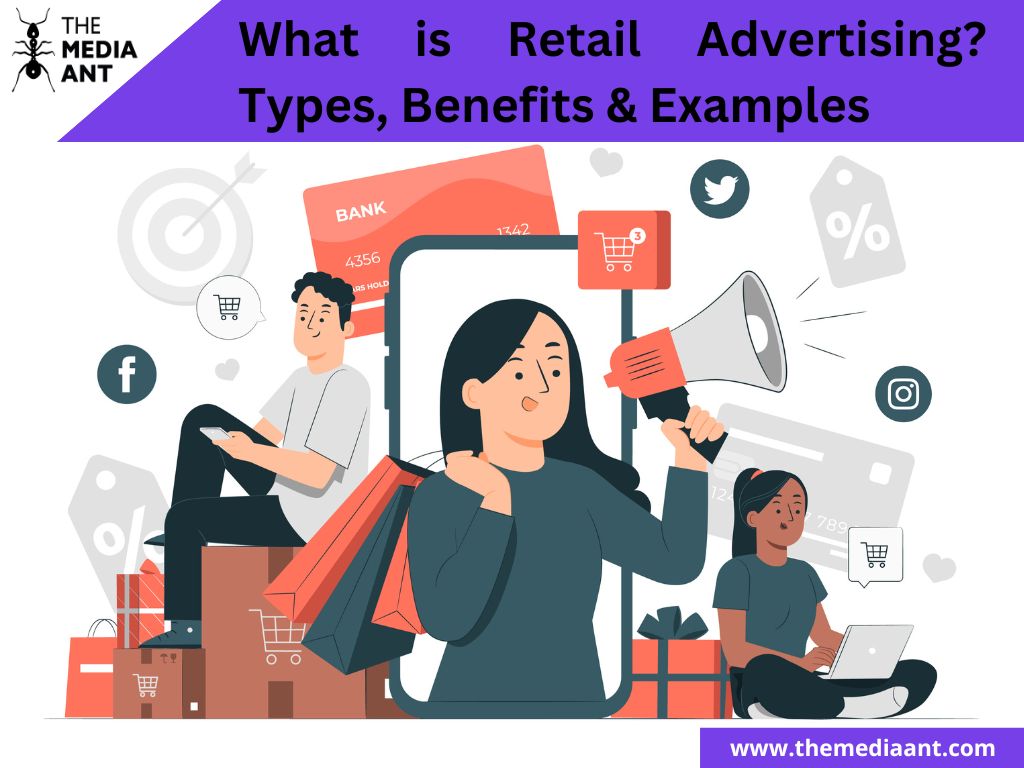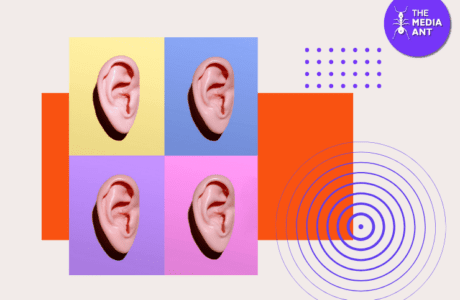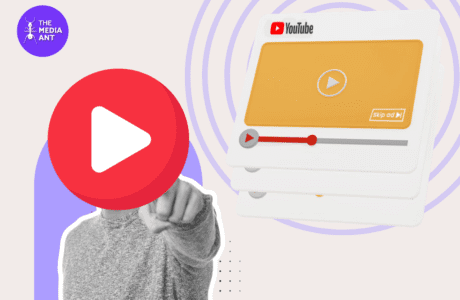Retail advertising unveils a dynamic landscape where strategies and creativity intersect to captivate consumers. This blog post delves into the diverse facets of retail advertising, unveiling its various types, the advantages it offers, and real-world instances that exemplify its effectiveness. From showcasing products on bustling shelves to crafting compelling in-store ads, retail advertising is key to engaging audiences and driving business success. Join us as we delve into this captivating domain, unravelling its intricacies and shedding light on its pivotal role in the modern marketing arena.
What is Retail Advertising?
Retail advertising is a marketing strategy focused on promoting products or services directly to consumers within a retail environment. It encompasses various advertising channels such as in-store displays, window displays, point-of-sale materials, flyers, and digital platforms. Retail advertising aims to attract potential customers, increase foot traffic to physical stores or online platforms, and ultimately drive sales.
It often highlights special offers, discounts, new arrivals, or unique selling points of products to entice consumers and create a sense of urgency. Effective retail advertising aims to enhance brand visibility, engage shoppers, and boost overall revenue for the retailer.
Types of Retail Advertising
Retail advertising encompasses a variety of strategies and channels to promote products or services directly to consumers within a retail setting. These strategies aim to attract customers, drive sales, and enhance brand visibility.
Here are some common types of retail advertising:
In-Store Displays
In-store displays are physical setups within retail locations that showcase products prominently. End caps, shelf talkers, and aisle displays catch shoppers’ attention, highlighting specific items or promotions. These displays often use creative visuals and signage to convey the value of products and encourage impulse purchases.
Window Displays
Window displays are eye-catching arrangements of products and visuals in store windows. They aim to draw passersby into the store by showcasing the retailer’s offerings in an appealing and thematic way. To maintain freshness and relevance, window displays often change with seasons, holidays, or promotional events.
Point-of-Sale (POS) Materials
POS materials include posters, banners, shelf danglers, and counter cards strategically placed near checkout counters. These materials provide customers with last-minute promotions, upsell opportunities, and complementary product suggestions as they finalise their purchases.
Flyers and Circulars
Printed or digital flyers and circulars are distributed in-store or via mail and email to inform customers about ongoing sales, promotions, and new arrivals. These materials provide a comprehensive overview of current offerings and encourage customers to visit the store or website.
Digital Advertising
In the digital age, online platforms play a crucial role in retail advertising. This includes:
Social Media Advertising: Retailers leverage platforms like Facebook, Instagram, and Twitter to target specific demographics with ads showcasing products, discounts, and engaging content.
Search Engine Advertising: Paid search ads, such as Google Ads, display products and promotions to users actively searching for related terms.
Email Marketing: Retailers send promotional emails to their customers, notifying them of sales, events, and exclusive offers.
Banner Ads: These graphical ads can be targeted on websites based on user interests and browsing behaviour.
Mobile Advertising
With the rise of smartphone usage, mobile advertising has become essential. Retailers can use location-based ads, mobile apps, and SMS marketing to reach customers on their mobile devices with personalised offers and promotions.
TV and Radio Advertising
While these traditional media forms have become less dominant, they still hold relevance for certain markets. Retailers can create commercials that convey their brand image and unique selling points, reaching a broader audience.
Direct Mail
Direct mail involves sending physical promotional materials, such as postcards or catalogues, directly to customers’ mailboxes. This approach allows retailers to target specific geographic areas or customer segments with tailored offers.
Loyalty Programs
Loyalty programs encourage repeat business by offering loyal customers rewards, discounts, or exclusive offers. These programs often utilise cards or apps to track purchases and offer personalised promotions.
Interactive Kiosks
Interactive kiosks within stores provide customers with product information, reviews, and the ability to place orders. They enhance the shopping experience and can help customers make informed decisions.
Augmented Reality (AR) and Virtual Reality (VR)
These technologies allow customers to interact virtually with products before purchasing. AR apps can project how furniture will look in a room, while VR can simulate experiences like test-driving a car.
Pop-Up Shops
Temporary retail locations, or pop-up shops, create a sense of urgency and exclusivity. These short-term setups often align with specific events or seasons and attract customers seeking unique offerings.
Cooperative Advertising
This involves retailers partnering with product manufacturers or suppliers to share the cost of advertising efforts. It benefits both parties by increasing product visibility and driving sales.
Catalogues
While less common today, some retailers still use catalogues to showcase their range of products. They can be distributed physically or accessed online.
Sponsorships and Events
Retailers can sponsor local events or host their own events to engage with the community and promote their products. This approach helps build brand loyalty and fosters a positive brand image.
Functions of Retail Advertising
Retail advertising serves a crucial role in the overall marketing strategy of businesses that sell products or services directly to consumers. It is a form of communication that aims to inform, persuade, and remind potential customers about the products or services offered by a retailer.
Here is an in-depth explanation of the functions of retail advertising:
Promotion of Products and Services
One of the primary functions of retail advertising is to promote the products and services offered by a retailer. Retailers showcase their products ‘ features, benefits, and unique selling points through various advertising channels such as print media, television, radio, online platforms, and social media. This helps create awareness among consumers and encourages them to consider purchasing those products.
Brand Awareness and Identity
Retail advertising plays a crucial role in building and maintaining brand awareness. Consistent and well-designed advertising campaigns help establish a retailer’s brand identity in the minds of consumers. This identity encompasses the retailer’s values, mission, and personality, differentiating it from competitors and fostering a sense of familiarity and trust among consumers.
Creating Customer Interest and Desire
Effective retail advertising is designed to pique customer interest and create a desire for advertised products or services. By using persuasive language, compelling visuals, and emotional appeals, retailers can stimulate consumers’ curiosity and aspiration, making them more likely to explore the offerings further.
Generating Sales and Revenue
The ultimate goal of retail advertising is to drive sales and revenue. Well-executed advertising campaigns can lead to increased foot traffic in physical stores or higher website traffic for online retailers. By showcasing limited-time offers, discounts, or promotions, retailers can create a sense of urgency and encourage immediate purchase decisions.
Informing about Special Offers and Events
Retail advertising serves as a platform to communicate special offers, sales events, and promotions. Retailers can use advertising to announce clearance sales, holiday discounts, buy-one-get-one (BOGO) offers, and other time-sensitive deals. This information helps attract price-sensitive customers and drives them to make purchases.
Educating Consumers
Retail advertising is a means to educate consumers about the features, benefits, and uses of products and services. In-depth product descriptions, demonstrations, and comparisons help consumers make informed purchasing decisions. By providing valuable information, retailers can establish themselves as knowledgeable and trustworthy sources.
Engaging Target Audience
Effective retail advertising engages the target audience through interactive and relatable content. This could include storytelling, user-generated content campaigns, quizzes, polls, and contests. Engaging content creates a stronger connection between the brand and consumers, increasing the likelihood of brand loyalty.
Building Customer Loyalty
Retail advertising is about attracting new customers and retaining existing ones. By maintaining a consistent presence through advertising, retailers can reinforce customer loyalty. Loyalty programs, personalised offers, and exclusive content for existing customers can be promoted through advertising to strengthen the bond between the retailer and its customer base.
Providing Contact Information and Directions
Retail advertising often includes information about store locations, contact details, and directions. This is particularly important for brick-and-mortar retailers, as it helps potential customers find their stores easily and conveniently.
Market Positioning and Differentiation
Retail advertising contributes to market positioning by highlighting the retailer’s unique value proposition and differentiating it from competitors. Effective advertising conveys why consumers should choose a particular retailer over others based on factors such as quality, price, convenience, and customer service.
Retail Advertising Budget for Better ROI
Allocating a well-considered retail advertising budget is essential for maximising Return on Investment (ROI). Focus on data-driven insights to optimise spending across various channels, targeting the most relevant audience segments. Prioritise digital platforms and track performance metrics in real-time to make agile adjustments. Invest in creative, engaging content that resonates with your target audience, enhancing brand recognition and customer loyalty. Regularly assess and refine your budget allocation to ensure efficient resource utilisation and a better ROI in the competitive retail landscape.
Retail Advertising Examples
IKEA
The two-page advertisement from IKEA, featured in the September 2022 edition of the REAL SIMPLE magazine, holds a significant impact due to several key factors.
Initially, the alignment of the brand with the magazine’s target audience is noteworthy. REAL SIMPLE caters to individuals seeking practical and ingenious solutions to simplify their hectic lives. This advertisement showcases an IKEA cart designed for multiple functions, resonating as a smart storage remedy.
Furthermore, the communication within the ad strongly underscores IKEA’s core strengths of affordability and user-friendliness.
Milani
In the cosmetics section of a typical drugstore, the aisle dedicated to beauty products is often bustling with options. However, makeup label Milani distinguishes its mascara through a compelling in-store advertisement that accentuates its unique selling points.
Within the ad, shoppers are presented with a set of images portraying the mascara’s impact, displayed through before and after snapshots that effectively showcase the product’s efficacy. Additionally, the advertising educates consumers about three distinct advantages of the mascara: its flake-resistant formula, long-lasting nature, and effortless removal process. To add a quantitative backing to their claims of quality, the ad also includes a user research statistic that solidifies Milani’s mascara as a reliable choice.
Retail Advertising Agency
With over a decade of experience, The Media Ant is a distinguished advertising agency excelling in Retail Advertising. Their expertise lies in crafting impactful campaigns that resonate with target audiences. Leveraging their deep understanding of the industry, they deliver innovative strategies, maximising brand visibility and customer engagement. The Media Ant’s track record speaks volumes, making them a trusted partner for businesses seeking to make a lasting impact in the dynamic world of retail.
FAQs Related to Retail Advertising
What is a retail advertising example?
A retail advertising example could be a clothing store promoting its summer collection through social media posts featuring vibrant images of the new arrivals and catchy captions highlighting the comfort and style of the outfits. The posts also mention a limited-time discount to encourage immediate purchases.
What is the role of retail promotion?
The role of retail promotion is to create awareness, attract customers, and boost sales of products or services. Through tactics like discounts, special offers, and contests, retail promotions entice consumers to make purchases while enhancing brand visibility and loyalty.
What is retail brand marketing?
Retail brand marketing involves strategies that position a retailer’s brand in the minds of consumers. It focuses on communicating the brand’s values, identity, and unique attributes to differentiate it from competitors, creating a strong and lasting connection with customers.
What are the five functions of retail advertising?
- Product Promotion: Showcasing products and their features to generate interest and drive sales.
- Brand Awareness: Building recognition and familiarity with the retailer’s brand identity.
- Creating Desire: Stimulating consumer desire for products or services through persuasive content.
- Sales Generation: Encouraging immediate purchases by offering discounts, promotions, and limited-time deals.
- Consumer Education: Providing information about products to help customers make informed decisions.
How do you advertise retail?
To advertise retail effectively, use a mix of strategies including social media marketing, email campaigns, search engine optimization (SEO), pay-per-click (PPC) ads, influencer collaborations, in-store promotions, and loyalty programs. Tailor your message to your target audience and track performance to adjust strategies as needed.






Hey, check out this cool article on retail advertising. It explains different types, benefits, and provides examples. It’s super helpful if you’re into marketing!